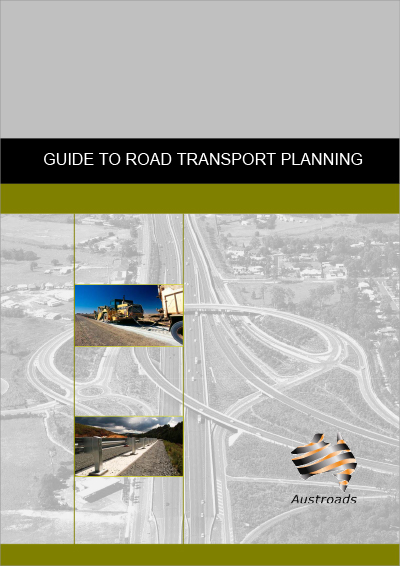Planning

- Publication no: AGRTP-09
- ISBN: 978-1-92155-106-2
- Published: 1 January 2009
- Edition: 1
- Superseded
- PDF (free) Download
The Austroads Guide to Road Transport Planning develops a map of jurisdictional road transport planning processes with particular focus at the road route and link level; and a best practice framework against which current road transport planning practice in Australasia may be assessed. Consultation with relevant government authorities (including surveys of all government agencies with a stake in road transport planning), and a review of relevant literature from Australia and overseas underpin the development of this Guide. Transport planning approaches and processes for roads vary widely across jurisdictions within countries as well as across countries and is probably more of an art than a science. This Guide discusses elements of good transport planning, current trends in transport planning, and best practice principles (e.g. land use and transport planning integration, multi modal planning and public consultation processes) required to achieve environmentally and socially sustainable transport solutions. It examines significant recent changes and a number of developments both internationally and in Australasia towards strengthening the existing legal and institutional road transport planning framework.
- 1. INTRODUCTION
- 1.1. Relationship to ATC National Guidelines
- 1.2. A Frame of Reference for other Austroads Guides
- 1.3. A Definition of Transport Planning
- 1.4. Structure of the Guide to Road Transport Planning
- 2. ELEMENTS OF GOOD TRANSPORT PLANNING
- 2.1. The Role of Transport Planning
- 2.2. Strategic Planning and Policy Framework
- 2.3. Role of Project Evaluation
- 2.4. Stakeholder Requirements
- 2.4.1. Cost
- 2.4.2. Resources
- 2.4.3. Planning Times
- 2.4.4. Need for Balanced Stakeholder Input
- 2.4.5. Importance of Good Data
- 2.5. Current Trends in Planning
- 2.5.1. Integrated Transport Planning
- 2.5.2. Multi-modal Planning
- 2.5.3. Sustainable Transport Planning
- 2.5.4. Planning for Urban Areas
- 2.5.5. Collaborative Planning
- 2.5.6. Land-use Planning
- 2.5.7. Community Service Obligations: Efficiency versus Equity
- 2.6. How Transport Planning Frameworks Adapt to Change
- 2.7. Challenges for Road Transport Planning
- 2.8. Principles for Planning in Urban and Rural Areas
- 3. INTRODUCTION TO THE ATC NATIONAL GUIDELINES FOR TRANSPORT SYSTEM MANAGEMENT
- 3.1. Introduction
- 3.2. Overview of the National Guidelines Transport System Management Framework
- 3.3. Systems Planning
- 3.4. Definition of Routes and Links
- 3.4.1. Levels of Transport Planning
- 3.5. Cross Cutting Components in the System Planning Process
- 3.5.1. Specification of Initiatives and Interrelationships between them
- 3.5.2. Development of a Program of Initiatives
- 3.5.3. Use of Route and Link Plans throughout the Transport System Management Process
- 3.5.4. Performance Review
- 3.5.5. Post-completion Evaluation
- 3.6. Implications of the National Guidelines for Transport Planning in Australia
- 4. SURVEY OF ROAD TRANSPORT PLANNING IN AUSTRALIA AND NEW ZEALAND
- 4.1. Background to the Survey of Road Transport Planning
- 4.2. Survey Methodology
- 4.3. Synthesis of Road Transport Planning in Australia and New Zealand
- 4.3.1. Synthesis Methodology
- 4.4. Synthesis of Survey Results of Road Transport Planning
- 4.4.1. Current Practice in Road Transport Planning
- 4.4.2. Current Practice in Guidelines Documentation
- 4.4.3. Degree of Development in Route and Link Planning
- 4.4.4. Relationships with other Levels of Government
- 5. BENCHMARKING TO BEST PRACTICE OF ROAD TRANSPORT PLANNING FOR EACH JURISDICTION IN AUSTRALASIA
- 5.1. Best Practice Principles for Road Transport Planning: Evidence
- 5.1.1. Strategic Planning and Policy Framework
- 5.1.2. Legal and Institutional Basis
- 5.1.3. Government Processes: Coordination, Integration and Levels of Responsibility
- 5.1.4. Community and Stakeholder Consultation
- 5.1.5. Integrated Land-use and Transport Planning
- 5.1.6. Demand-based Transport Planning
- 5.1.7. Sustainability and Environmental Implications
- 5.1.8. Multi-modal Road Transport Planning Requirements
- 5.1.9. Importance of Transport Models/Tools and Data
- 5.1.10. Funding (Budget) Considerations
- 5.1.11. Implementation, monitoring and feedback mechanisms
- 5.2. Best Practice Principles Framework
- 5.3. Best Practice Mapping
- 5.4. State of Road Transport Planning in Australasia
- REFERENCES
